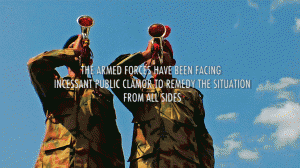« Reviews
Shahzia Sikander

Shahzia Sikander, video still from Bending the Barrels, 2009, digital video, colour/sound, 20'. Courtesy Pilar Corrias Gallery.
Pilar Corrias Gallery - London
By Michele Robecchi
Praise for Pilar Corrias Gallery is well-deserved. In little more than a year, the gallery has established itself as a driving force amongst the very competitive UK art scene, introducing young guns such as Patrick Tuttofuoco, rejuvenating old masters like Miguel Barcelò, and bringing to London artists who, despite their international recognition, quite unbelievably have never had the opportunity to have a solo show in town.
In this latter category falls Shahzia Sikander. The Pakistan-born, US resident artist emerged in the mid-1990s with a series of works deeply indebted to Indo-Persian miniature painting–which she studied while attending the National College of Arts in Lahore–and her personal experience, largely brought into the picture through the exploration of memories, and how these relate to her present condition. Such a combination of private and traditional elements is carried out with a great sense of immediacy, possibly the result of a practice still quintessentially based on drawing.
Sikander’s exhibition in London, titled “I am also not my own enemy,” is inspired by Ghalib, an authority in the Urdu interpretation-defying poetry genre known as Ghazal, and is inscribed in graffiti fashion at the center of a large painting. Fused with the fragmented poetry, the painting creates a tension between the abstract and the representational, blurring the dividing line between popular and elitist art, as well as depicting a perennial shift in meaning.
Bending the Barrels (2009), Sikander’s latest video, is a 15 minute journey through military rhetoric and pageantry (different groups of soldiers are portrayed while playing music), which shows how a form of artistic expression can be turned into a political statement. Inspired but nonetheless authoritative, the army men’s performance is occasionally paired with military jargon, like “We were left with no options,” “We were asked to be here,” and “The situation is now calm, stable and under control”– the kind of rhetoric aimed at defusing a situation but that people should not really hear, especially when things really are calm, stable and under control.
The current political climate in Pakistan and the country’s long struggle for democracy are at the core of the piece, but what is really striking is how even in the strongest moments of group affirmation, Sikander makes the personality of every single man involved vividly perceivable. The gentleness and sense of discipline they emanate are an invitation to revisit the piece, revealing how even the most apparently mono-dimensional situation involves multi-layered realities.
(October 16 - November 21, 2009)
Michele Robecchi is an Italian writer and curator based in London. He is currently a visiting lecturer at Christie’s Education and an editor at Phaidon Press.
Filed Under: Reviews


































